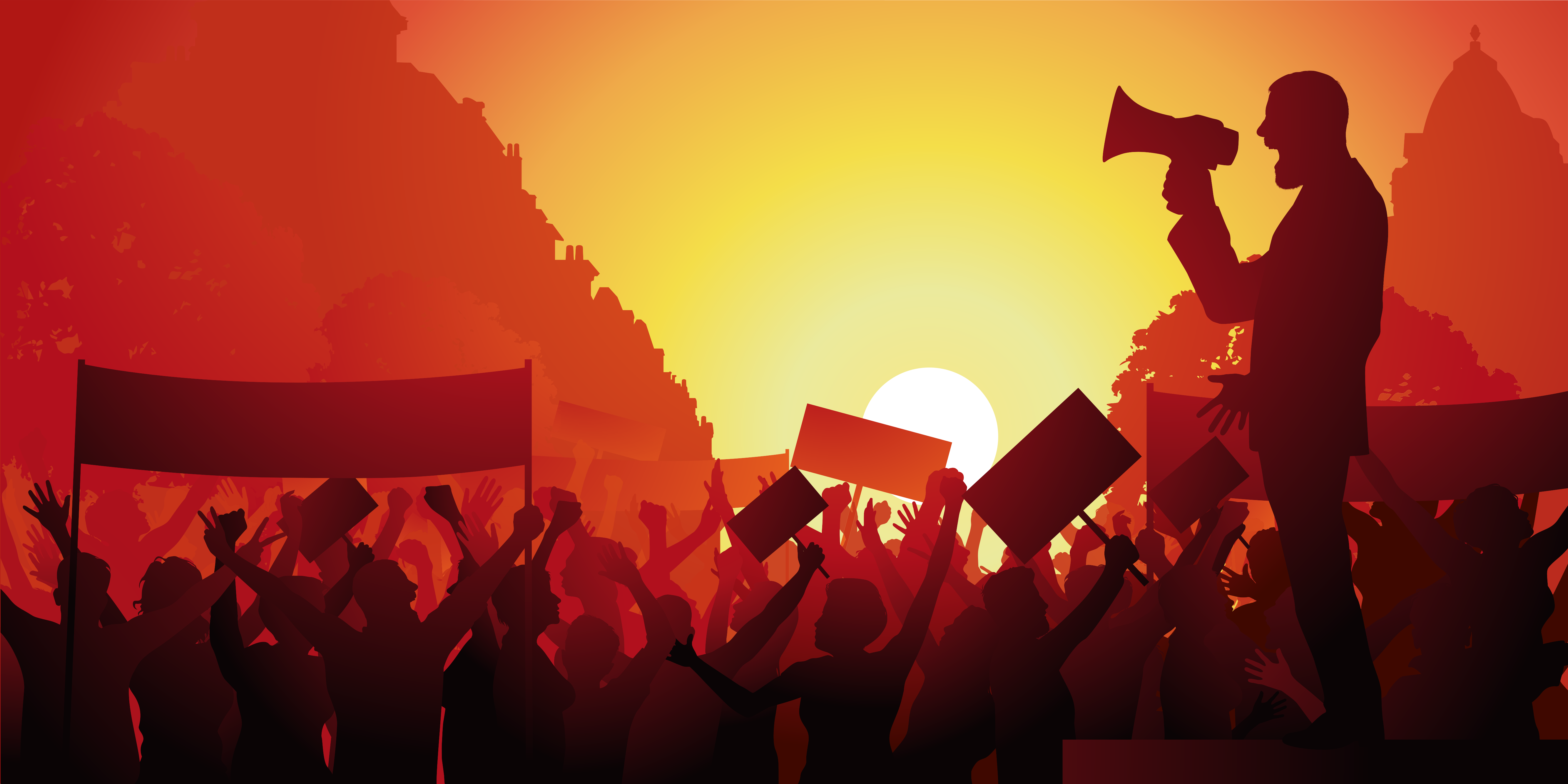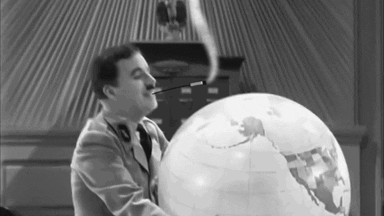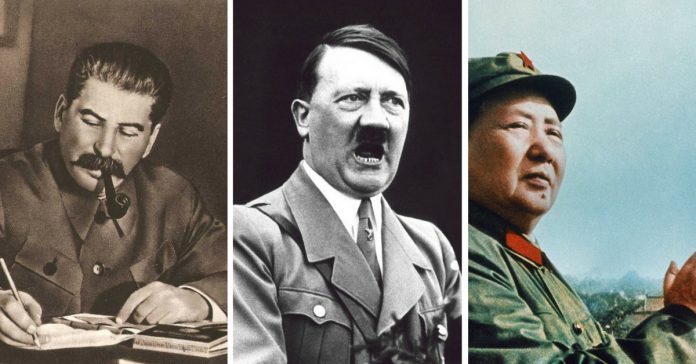
A dictatorship is an authoritarian government in which one person holds all (or nearly all) of the ruling power. They are known for being dangerous and malevolent – usually run by an evil, mean-spirited sociopath. Many ruthless dark dictators in history have displayed a propensity for brutality and violence. Learn about the most notorious ones and what we can learn from their downfalls. (Estimated reading time: 12 minutes)
“When dictatorship is a fact, revolution becomes a right.”
— Victor Hugo
Most people are aware of the emotional dangers of getting close to those who exhibit strong narcissistic or sociopathic traits.
These toxic individuals who have a pernicious effect on us show behaviors of grandiosity, self-centeredness, arrogance, power-mongering, and a lack of empathy and compassion.
The good news is that those on the higher end of the narcissism and sociopathic continuum are rare. Research estimates that people with narcissism range from 1% to 6% and 0.2%-3.3% for sociopathy of the population. Many resources provide warning signs to look out for.
It’s easy to spot toxic people in our workplaces and social settings to steer clear of them. But what if these individuals rise to positions of absolute power and have control over the places they occupy? History shows it leads to human rights abuses, social turmoil, and poverty.
The scary part is that there is no reliable way to prevent ill-intentioned and incompetent people from gaining power. Dictators have risen unexpectedly, even among the educated and prosperous, who never saw their ascent to power coming. They take advantage of unstable economic and social conditions and a need for change, resorting to coups and violence.
The dark and sinister regimes of powerful dictators have cost millions of innocent lives and broken the spirit of the people they ruled in Asia, Europe, Africa, and South America. Those who survived were manipulated and brainwashed to follow their diabolical plans and support terrible things.
By looking at the power dynamics in the regimes of dark dictators in history, we can learn how they rose to power, thrived, and, more importantly, what led to their inevitable downfalls.
What is a dictatorship?

A dictatorship is an authoritarian government in which one person holds all (or nearly all) of the ruling power. The term “dictatorship” comes from the Latin title ‘dictator’ from the Roman Republic, which granted extraordinary powers to a temporary magistrate to deal with state crises and emergencies.
A modern dictatorship is a form of government that rose to prominence in the 19th and 20th centuries. Historians believe this was due to a decline in monarchies. It was also during this time that constitutional democracies were spawned.
Dictators have absolute power over the state and can enact the law, often enforcing extreme measures and strict rules that curtail human rights and freedoms.
Dictators often adopt different titles due to the negative connotations. For example, Adolf Hitler adopted the title “Führer,” meaning guide or leader.
Unlike other forms of government, dictators are not held accountable by governing bodies and constitutional limitations. This is similar to a monarchy, but unlike a monarch who inherits their role, a dictator seizes control of a state by force. A monarch also has the best interests of their people in mind, whereas a dictator focuses on dominance and self-glorification.
How do dictators control citizens?
Dictators usually resort to force or fraud to gain despotic political power, which they maintain through intimidation, terror, and the suppression of fundamental civil liberties.
These leaders may also employ mass propaganda techniques and only provide the information they want citizens to have to sustain their public support. They use fictional stories that reinforce their greatness and lie about their country’s willingness to promote their political view or cause.
Dictators are also notorious for using psychological tactics, like cries of righteousness and patriotism. They tell the public what they want to hear and inflame their wish to believe.
Their use of rhetoric is based on confirmation bias, which causes people to look for evidence to support the ideas presented while ignoring contradictory information. Using this cognitive shortcut, they sway the populace’s minds in their favor.
Dictators have power over the economy and military. The more corrupt ones also use threats and brutality to control the population.
Dictatorships are notorious for infringing on human rights and organizing unfair or absent elections. They also limit the liberties of their citizens as a preventative measure.
Extreme forms of dictatorship restrict occupations, religious beliefs, and the number of children a family can have. Regardless of how oppressed people feel, they are required to show their support for the dictator by attending marches and public celebrations.
Modern dictatorships are becoming more creative and sophisticated in their approaches by learning from their predecessor’s failures. They are sensitive to a heavy-handed approach as it can trigger concerns over human rights from foreign governments and international organizations. It can also provoke internal opposition.
What are the different types of dictatorships?
In 1999, political scientist Barbara Geddes created a classification of dictatorship to show where the power lies. Under this system, there are three types of dictatorships:
1. Military
Military dictatorships form after power is obtained through military action. The military officers maintain power, take control, install a director of their choice (usually the highest-ranking military officer), and use force to preserve their hold on the nation. These regimes are often unstable and last for five years or less. Military dictatorships are common in developing countries in Asia, Africa, and Latin America.
2. One-party state
Multiple parties may exist in this type of government, but one political party dominates and makes all the rules. They control every aspect of each election and have the power to disseminate propaganda that guarantees their win. One-party states were common during the Cold War and the fall of the Soviet Union. They are more stable, longer lasting, and less susceptible to insurgencies than military dictatorships.
3. Personalist
Personalist dictatorships are regimes where all the power lies in the hands of one individual whom the military or a party may support. They can place their loyal followers (regardless of their qualifications and competence) in positions of power and create cults to shift public opinion to their side. If there are critics, they use violence and secret police to silence them. Personalist dictators rely heavily on their charisma and personality.
Due to a lack of accountability, these dictatorships are more repressive and prone to corruption than other forms of authoritarianism. Because all the power is in one person’s hands, the personalist dictatorship ends with the dictator’s death and usually ends in violence.
Other types of dictatorships
Absolute monarchy: In some cases, monarchies are also considered dictatorships. Absolute monarchs hold a large amount of political power without legal limitations. This makes it different from ceremonial and constitutional monarchies. Absolute monarchies are most common in the Middle East.
Hybrid dictatorships: As the name suggests, hybrid dictatorships combine the elements of the other four types. An example of a hybrid dictatorship is the military/single-party hybrid in El Salvador from 1948 until 1984.
Why dictatorships don’t work in the long-run

Dictatorships are notorious for being dangerous and malevolent – usually run by an evil, mean-spirited sociopath out to serve their own interests.
While there is some truth to that, there have also been dictators in history, like Anwar Sadat and Napoleon, who improved the lives of their citizens.
There is also a humane version of dictatorship known as a benevolent dictatorship, where the authoritarian ruler exercises absolute power over the state but does it for the benefit of the population. They may allow for some democratic decision-making and civil liberties.
Dictators with a sound ethical framework and those that adhere to a form of enlightened despotism have and do exist, but most dictators abuse their power and are not held accountable for their actions.
The biggest reason why dictators fail in the long run is because they curtail freedom. People want to live their best lives – they want full and prosperous lives where they can tap into their highest potential. They can pursue this ideal only when they have rights and are left as free as possible.
Autocracies restrict freedom to establish order and gain control. They can go as far as violating fundamental human rights and conducting genocide on specific groups and races – the most notable being the Holocaust, where Adolf Hitler targeted Jewish people. During his dictatorship, eleven million perished, six million of whom were Jews.
When people endure prolonged oppression of freedom, they reach a breaking point where they rebel. This gives rise to movements and revolutions that pave the way for more just forms of government that don’t infringe on their rights and allows them to have a say in how the country’s affairs are run.
Six dark dictators in history from around the world

Many ruthless dictators in history have displayed a propensity for brutality and violence. This list includes dictators from modern history.
It’s also important to note that the nefariousness of these dictators is not just based on the number of deaths they were responsible for but how extreme they were in their race to secure power and influence.
1. Adolf Hitler
In power: 1933-1945
Austrian-born German politician Adolf Hitler is one of history’s most well-known and condemned figures and prominent dictators in history. As the dictator of Germany, he orchestrated World War II and was the primary instigator of the Holocaust. In two years, Hitler’s Third Reich Empire spanned most European countries. He systematically destroyed anyone who did not match his criteria for the Aryan race, which he considered the “ideal master race.”
His ruthless approach resulted in the persecution and deaths of Jews, Slavs, and any other group he believed was socially undesirable. They were thrown into concentration camps, and his genocidal policies caused the deaths of millions.
He is likely responsible for the largest destruction and loss of human life brought about by one person in history. The Führer eventually succumbed to the pushback against his regime and committed suicide after the Allied Forces defeated Nazi Germany.
2. Mao Zedong
In power: 1949-1976
Mao Zedong was an influential Chinese communist leader who ruled with an iron fist and founded the People’s Republic of China. Also known as Chairman Mao, he was known for his political theories, military strategy, and a communist revolution – all collectively known as Maoism.
Mao held absolute power over China and is revered by many as a great leader because of his policies and efforts to modernize by improving healthcare, education, and women’s rights. This eventually led China to its position as a dominant world power.
Unfortunately, Mao Zedong was an exceptionally ruthless ruler as well. During his regime, he took control of all agriculture and industry and encouraged forced labor, leading to the death of over 55 million people through mass executions and starvation. He also ordered the destruction of many cultural and religious artifacts.
Mao’s relentless efforts to achieve power and his suppression of opposition, poor planning, and disregard for human life proved devastating, leaving a trail of destruction through China’s history.
3. Vladimir Lenin
In power: 1917-1924
Vladimir Lenin was notorious for his communist views and rebellious political rhetoric. He was adamant about replacing capitalism with socialism and supporting Marxist policies.
After the Russian Tsar was overthrown in 1917, Lenin took advantage of the opportunity and led a revolution to seize power. He subsequently established the USSR, a dictatorship controlling all aspects of society and implementing a strict command economy.
During a period of war, revolution, and famine, he demonstrated a cold disregard for the suffering of his people and crushed anyone who opposed him.
He took a ruthless approach to his opponents, killing thousands in concentration camps and allowing people to perish without any attempt to improve their living conditions.
4. Joseph Stalin
In power: 1922-1953
Joseph Stalin was a politician, political theorist, and dictator of the Union of Soviet Socialist Republics (USSR) from 1929 to 1953. As Lenin’s successor, he wasn’t any less aggressive and took whatever measures he needed to transform a peasant society into a military and industrial superpower. Before his death, he proved to be one of the most powerful dictators in history.
His methods to achieve his vision have been condemned by many. Under his leadership, millions of his citizens died because of his policies, like the Five-Year Plan, which contributed to widespread famine. He imprisoned over a million people and executed over 700,000 during “The Great Purge,” a movement he spearheaded to rid Russia of the working class, whom he considered the enemy.
Despite the loss of life, suffering, deportation, mass repression, and ethnic cleansing, some people in Russia still think that Stalin’s political views have merit. He cooperated with the United Kingdom and the United States during World War II, but later proved to be a divisive figure with a strained relationship with the West during the Cold War era.
5. Saddam Hussein
In power: 1979-2003
Saddam Hussein was an Iraqi dictator who became the country’s de facto leader in 1979 until a US-led coalition invaded Iraq and ousted his government. He was subsequently executed in 2006 for his crimes.
Hussein is among the best-known Middle Eastern dictators because of the atrocities he committed and his inability to cooperate with other leaders. Notorious for the murder and torture of thousands of his people divided by religion and ethnicity, he maintained a firm grip on his power, and nothing stopped him from punishing his critics.
In addition to participating in human rights abuses, he led Iraq into war with Iran and Kuwait, paving the way for the Persian Gulf War. After refusing to cooperate with the U.S. and its allies, a UN-mandated international initiative intervened to prevent the war from exacerbating.
6. Idi Amin
In power: 1971 to 1979
Idi Amin was a Ugandan military officer who rose to power through his service in the British Colonial Army, where he became a Lieutenant before Uganda gained its independence in 1962. He overthrew the Ugandan government in a military coup and declared himself the new president.
His brutality and cruelty earned him the nickname “Butcher of Uganda.” During his eight years in power, 100,000-500,000 people were killed by his command. It has even been rumored that Amin was a cannibal who occasionally consumed his victim’s flesh and organs.
Amin eliminated ethnic minorities and political officials via torture, execution, jail sentences, and launched repressive measures against his people for no reason. He also severely mismanaged the economy and was responsible for overwhelming corruption.
Amin moved Uganda away from a pro-western stance and aligned the country with Soviet policies and ambitions. With the Soviets on his side, he initiated devastating attacks on political protectors and specific ethnic groups to stabilize his regime. Like most military dictatorships, Amin’s hold on Uganda was short-lived, and he was ousted in 1979 and forced into exile.
Other dark dictators in history: Muammar Gaddafi, Fidel Castro, Benito Mussolini, Pol Pot, Kim Jong-il, Robert Mugabe, Francisco Franco.
While it’s easy to vilify dictators, in many ways, it’s the public who enables them. Dictators cannot function and gain power without the support of followers.
It can seem tempting to have others tell us what’s right and wrong – especially if they are confident and charismatic. We must hold on to the personal responsibility of expressing our thoughts and standing up for our beliefs. In this way, we can collectively prevent autocracies from impeding our freedom and growth as a civilization.
All my best on your journey,
Seline

Questions for you: Which of the dark dictators in history do you believe led the most ruthless regime and why? Which personality traits and decisions do you think led to their downfall?
Did you like this post? Sign up below, and I’ll send you more awesome posts like this every week.

Excellent article! It’s so applicable to today’s world. Modi of India and Viktor Orban of Hungary are likely sociopaths. Trump is a sadistic, Machiavellian sociopath, whom I consider to have the Dark Tetrad Personailty.